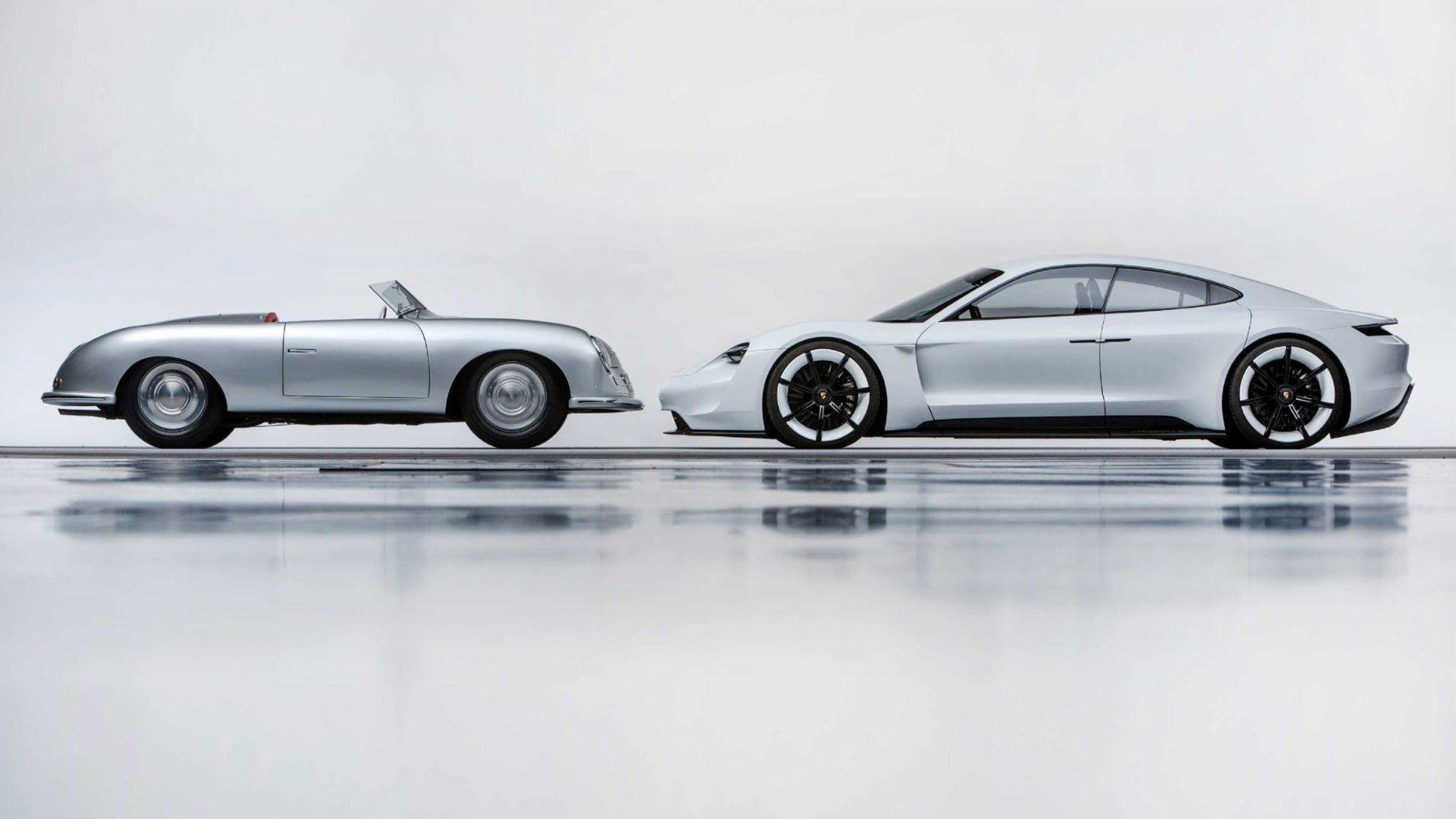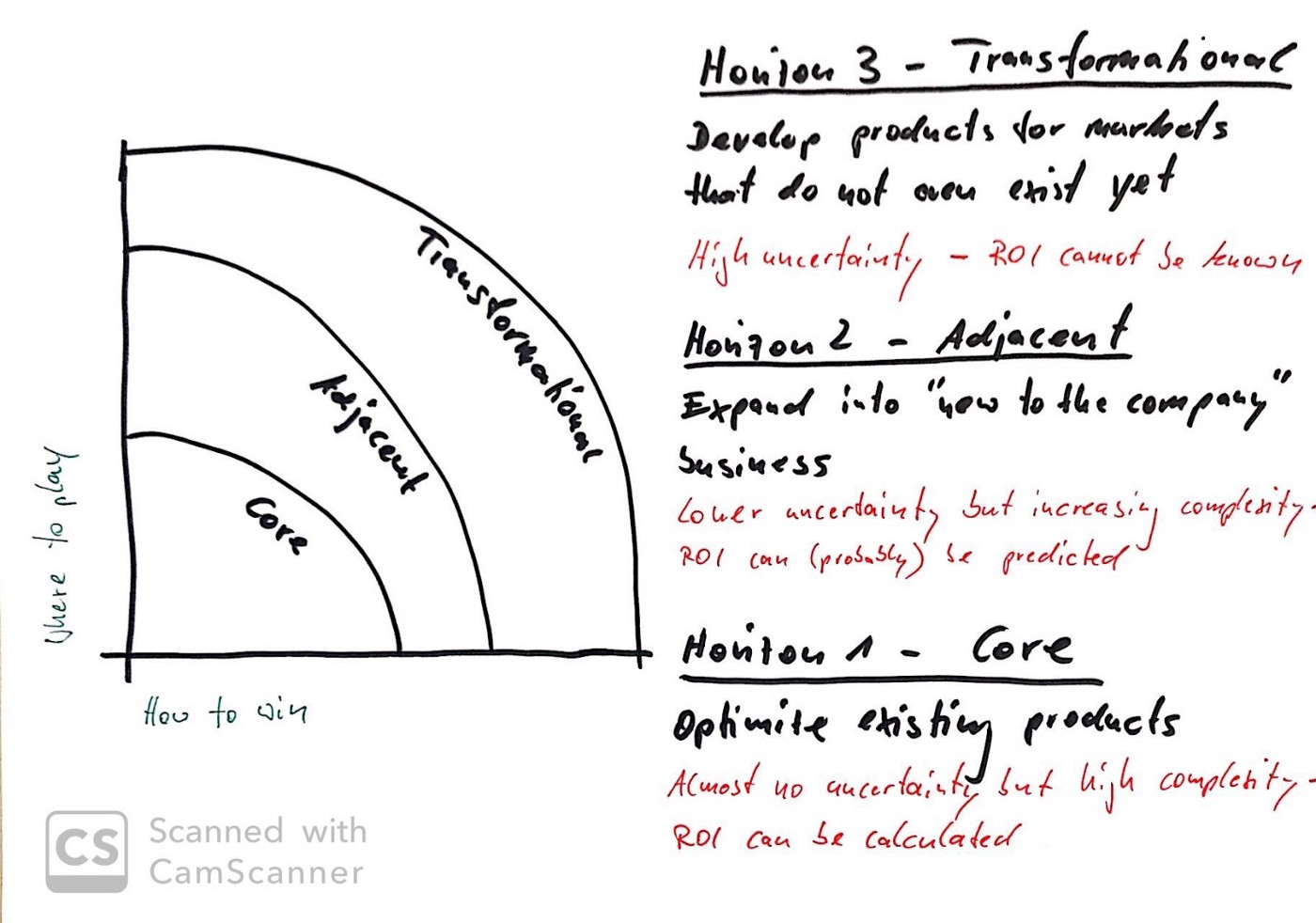Because innovation never ends and you can only be successful if you make the organization itself more innovative instead of hiring people to “do” innovation for you. If you’d like to know about this mindset, check out my last article.
In a recent interview, our CFO Lutz Meschke pointed out one of Porsche’s big challenges when it comes to being more innovative: “Our corporate culture has been shaped by the field of engineering, and we are very good at continually optimizing things further. But that can only continue for a few more years.”
Assessing our skills: Next Level Engineer Thinking
I absolutely agree with this and I want to put those words in perspective, using the Innovation Ambition Matrix, a simple modification of a strategy framework called Ansoff-Matrix. Internally, we use this instrument quite a lot to explain the different challenges of innovation and it really helps to structure this broad topic.
Basically, the Innovation Ambition Matrix looks at markets and products. The core innovations mentioned in the matrix as horizon 1 are the incremental changes made to existing products for our existing clients. Whereas the transformational innovations in horizon 3 mean “new to the world” products we present to different markets and target groups. In-between are the adjacent innovations in horizon 2 that include products and services that are new to business for the company but have been seen before in the market.
The challenge is, though, that the ways to approach those horizons differ fundamentally:
Horizon 1: Know your products and your clients
In core innovation projects, Porsche is very successful due to operational efficiency and incremental improvements. We know our products, our clients and we know how to assess if a project is worth being followed — probably using simple Return on Investment (ROI) metrics. However, since products and services developed here are deeply connected with our core business, their complexity is higher than in other horizons.
Horizon 2: Old shoes in new markets
Broaching the adjacent innovations, we take something we are already good at and use this to target something new. In this case, we can keep uncertainty low and predict ROI. The Taycan is a good example for that approach — we developed it following our long experience in sports car manufacturing, but it will be the first fully electric Porsche coming to market this fall. Therefore, it might sell to an entirely new customer group we currently do not serve with our established product portfolio.
Horizon 3: Transformational innovation
Transformational innovation initiatives are the king of business development. They include developing a product for a market that does not yet exist — no certainty or prediction possible. Transformational innovations probably take capabilities we haven’t even developed yet. The only way to get these capabilities: test and experiment fast and often, understand the relevant questions you need to answer for the product to excel. Only by gaining feedback directly from our customers we can understand and continuously improve our work, products, and services. The good thing within this horizon is that it does not interfere with the running business, thus — despite the uncertainty — the complexity is not that high.
How to balance total innovation
Porsche, like other corporates, has to be able to pursue different tracks of innovation — all at the same time. Rather than bringing forward stand-alone innovation initiatives which compete for funds, time, and attention with one another, Porsche has to implement a holistic innovation approach to be successful in the future. For Porsche, that means establishing a balance between our core, adjacent, and transformational innovation initiatives.
Now, this is the tricky part. To produce cars quickly, in high quality and with a high margin, Porsche has to work like clockwork. What does that mean? Not only a rather linear mindset, but also little time to educate ourselves in new work methods and to take part in innovative projects — apart from the daily business.
So, how can we buy us more time in order to meet the requirements of the different horizons?
AI: Transforming Finance & IT
That’s where AI comes into play. When most people think about Artificial Intelligence (AI), they probably think about self-driving cars, robots from Boston Dynamics or similar things. When we at the Porsche Finance & IT department think about AI, we fiddle about how to improve standard processes in order to preserve our precious human resources.
Wouldn’t it be nice if a machine could take over those repetitive tasks? If we could win time to work on the exciting stuff? Intelligent technology will give us the so badly needed free time. Time that we can invest in the preparation for the future, interesting experiments, and great new products — reaching out from horizon 1 to 3.
As a McKinsey study about the effects of AI in Finance states, the technology can fully automate 42 percent of finance activities and mostly automate a further 19 percent — this includes robotic process automation (RPA), even though that is not a very intelligent technology. If we could really enhance our processes to such an extent, we would free up our most valuable resources — our employees — in order to teach and train them to tackle the challenges to come.
Learning what AI can and cannot do
Interestingly, Artificial Intelligence is not only a tool to support Porsche’s employees, but it is also a great example of how the company itself is already learning and transforming. In 2017 and 2018, our innovation department tested AI in various pilot projects, experimenting with all three innovation horizons to understand what the technology can and cannot do. In those two years, we learned valuable lessons, especially which questions to ask in order to make AI scalable and to understand which capabilities are needed.
Not very surprisingly, it became quite obvious: Artificial Intelligence can do a lot. So, it is not without reason that our CIO Matthias Ulbrich made AI one of the main pillars of Porsche’s IT strategy. As one key technology, it can e.g. help us to balance our different tracks of innovation at Porsche. With the help of intelligent technology, we can enhance our core initiatives, empower operations in the adjacent horizon and create the right conditions for transformational innovations. Besides that, AI also poses its own challenges — not only on the technological side but especially in terms of organization and culture. At Porsche, our AI@Porsche initiative gathers all the activities around AI at Porsche as part of our digitization strategy — such as the AI Monday that we now brought to Stuttgart. We need to address all those different levels to fully leverage the potential of AI. I am looking forward to contributing to this process with my work in the Finance and IT department!


